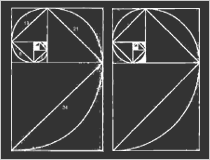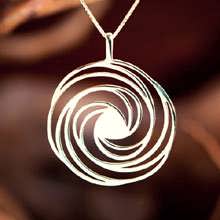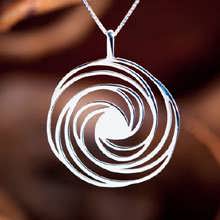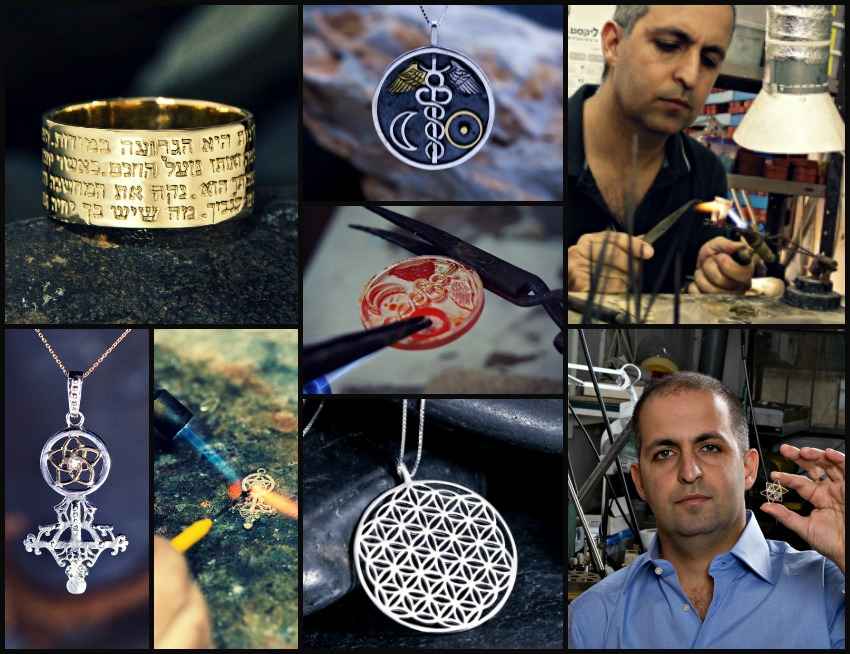Golden Spiral
Symbol of Harmony and Beauty
Golden Spiral Shape
The
Golden Spiral structure represents
two well known sacred geometry shapes: the
golden mean (phi) spiral and the
Fibonacci spiral. It is a based on a crop circle
shape known as the "Hackpen Hill Formation" and it appeared in an English wheat
field in 1999.
Phi (golden mean) - "The key to the physics of the cosmos" (plato)
Phi is a constant value which is even more
mysterious and profound
in its implications than pi. Like pi, phi is a number with no arithmetical solution.
The decimals just keep on going into infinity without ever repeating themselves.
The unique thing about this number is that it can be found incorporated in all
known organic structures. From the bone structure of human beings to the seed
pattern of a sunflower to the spiral of a sea shell, the phi proportion is there,
underlying all biological structures, seeming to be a
geometrical blueprint for life
itself.
Plato went so far as to call the phi
ratio the "
key to the physics
of the cosmos". Phi is calculated at 1.6180339+..., and while it cannot
be worked out arithmetically, it can be easily obtained with a compass and straightedge.
Finding the golden mean
Two simple ways of finding the Golden Section geometrically are as follows:
Method one
If you take two equal squares, side by side, (a 1x2 rectangle), divide one of
the squares in half, and with a compass, swing the diagonal down to the base
of the other square, the point where the diagonal touches the base will be phi,
or 1.6180339+, in relation to the side of the square, which is 1 (This formula
also describes exactly the rectangular floor of the King's Chamber).
Method two
The other method of determining the Golden Section is by dividing a line segment,
AB, at a point C, in such a way that the whole line is longer than the first
part in the same proportion as the first part being longer than the remainder.
AB/AC = AC/CB = 1.6180339 (notice the fractal and holographic nature of this
ratio...).
Whoever cultivates the golden
mean,
avoids both the
poverty of a hovel and the envy of a palace.
(Ancient Roman poet)
Golden mean in architecture
The
phi ratio is found in the architecture
of the
Great Pyramid in the triangle
formed by the height, half-base, and the apothem, or diagonal. In other words,
the basic cross - section of the structure demonstrates the
Golden
Section. If the half - base is given a value of 1, this gives the value
of phi for the apothem, and the square root of phi for the height. The Golden
Section shows up again and again in
Giza
and in much more baffling and tedious ways (Entire volumes have been written
on the geometries involved in the pyramids construction).
Fibonacci sequence and the golden spiral
| There is a number sequence, known as
the Fibonacci sequence, which
bears a special relationship to phi, and to the pyramids at Giza. First
postulated by the medieval mathematician Leonardo Fibonacci, this
sequence was used to describe the growth patterns of plants. It goes:
1,1,2,3,5,8,13,21,34,55,89,144,233, etc. It is made by adding the last
two numbers of the sequence to get the next one, as in: 1+1=2, 1+2=3,
2+3=5, 3+5=8, 5+8=13, etc. |

|
This sequence's relationship to phi is that if you divide one term of the sequence
into the next one, the result begins to quickly approach the transcendental
number 1.6180339+... (I won't make you do the math. Just watch...)
1/1=1 2\1=2 3\2=1.5 5\3=1.66 13/8=1.625
21/13=1.615 34\21=1.619 55\34=1.617 89\55=1.6181
The further you go down the sequence, the closer you get to phi. Of course,
you can never actually get to it exactly, since it has no mathematical solution,
it just keeps getting closer and closer, to infinity.
The sequence can be graphed out in the form of a spiral, called the
Fibonacci Spiral. This spiral is almost identical
to the graph of the logarithmic spiral of the phi ratio, known as the Golden
Mean Spiral (The difference is that the Fibonacci spiral is a whole number interpretation
of the arithmetically impossible Golden Mean spiral, which has no beginning
or end. The Fibonacci spiral has a definite beginning).
Fibonacci spiral and the pyramids of Giza
Aerial photographs show that the pyramids at Giza are positioned in such a way
that they fall on a line which accurately defines a Fibonacci spiral. The spiral
passes exactly through the centers of each pyramid.
About the Author
David Weitzman
The jewelry artist David Weitzman combines ancient and sacred knowledge into a unique line of jewelry designed to bring people both beauty and inspiration. David's artwork harnesses the power of spiritual symbols and sacred geometry from around the world to bring those wearing this sacred jewelry happiness, vitality, excitement, and love.




![]()
